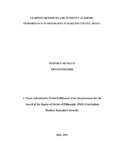Learning resources and students’ academic performance in geography in Makueni county, Kenya
Abstract
This study investigated the relationship between learning resources and students‟
academic performance in geography in KCSE in public secondary schools in Makueni
County. The objectives of the study sought: to establish the variety of learning resources
used in the teaching and learning of geography in public schools in Makueni County
and their effect on KCSE performance in the subject in the county; to find out the
availability of learning resources for the teaching and learning of geography in public
schools in Makueni County and its effect on KCSE performance in the subject in the
county; to establish the use of learning resources in the teaching and learning of
geography in public schools in Makueni County and its effect on KCSE performance in
the subject in the county; and to find out the relationship between teacher training on
learning resources and its effect on KCSE performance in geography in public schools
in Makueni County. The study was guided by the Classroom Instruction Theory using
the descriptive survey design. Both stratified and simple random sampling methods
were applied in drawing a sample. Data was collected from 422 respondents who
included 29 principals, 30 teachers of geography and 363 Form Three students. Data
was collected using questionnaires and an observation checklist. Questionnaires were
used to collect data from principals, teachers and students. The observation checklist
was used in observing geography lessons. Both descriptive and inferential statistics
were used to analyse quantitative data and included means frequencies, crosstabulations, percentages, correlation and regression analysis. Qualitative data analysis
was done using a mixed method of case by case analysis as well as cross case analysis.
The findings of the study were: correlation between availability of learning resources
and performance in geography at 0.401; correlation between the use of learning
resources and geography performance at 0.631; correlation between variety of learning
resources and performance in geography at 0.196 and finally, correlation between
training of teachers and KCSE performance in geography at 0.197. Null hypotheses on
variety, availability and use of resources were rejected while null hypothesis on training
of teachers was adopted. The study therefore concluded that while access to variety of
learning resources, availability of learning resources and use of resources in the
teaching and learning process promoted academic performance in geography in KCSE
in public secondary schools in Makueni County, pre-service teacher training on learning
resources did not. Recommendations made were: to sensitize teachers to be innovative;
teachers to use a variety of learning resources in teaching; school heads to encourage
their teachers to attend in-service training; MOE and TSC to ensure further training
opportunities to teachers; the content of training opportunities like symposia and
workshops to be scrutinized and areas of weakness identified and strengthened; and
finally, the use of emerging technology, especially ICT given more consideration in
teaching/learning geography. Recommendations for further research were: duplicating
the research to probably cover all of Kenya; establishing the content of the symposia
and workshops, their usefulness to teachers, what can be done to improve their
usefulness; and finally, conducting a multivariate study relating performance in
geography with entry behaviour of learners into secondary school and use of learning
resources in teaching/ learning be conducted
Collections
- MKSU Doctoral Theses [51]

